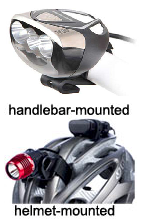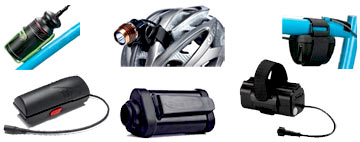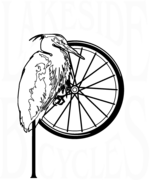Buyer's Guide To Rechargeable Light Systems
 You know this trail as well as you know your TV remote, yet you flinch with every rogue shadow that passes under your wheels. Blasting through the trees and navigating the rock gardens with focused tunnel vision, you wonder how close that drop-off to the left really is.
You know this trail as well as you know your TV remote, yet you flinch with every rogue shadow that passes under your wheels. Blasting through the trees and navigating the rock gardens with focused tunnel vision, you wonder how close that drop-off to the left really is.
Yes, you know this trail, but under the dim moonlight, you're riding it again for the first time.
Welcome to the world of night riding! Besides great fun, and a unique and exciting experience, night cycling is a fine way to fit your passion into a busy schedule. It's also a wonderful escape from the scorching sun and crowded trails.
A good light system turns night into day
For this type of riding, you need one of our powerful and reliable rechargeable lighting systems. These have the oomph to turn night into day and make even technical trail riding possible after dark.
They boast a powerful bulb(s) and a rechargeable battery that fuels the light for a couple of hours, at least. These are sophisticated systems with many features and a wide price range. In this article, we explain some of the differences to help you choose the right light.
First, a word about tail-lights
While some high-tech rechargeable lighting systems offer taillights, most come with a headlight only. That's because the most common use for these lights is off-road bicycling where a taillight is unnecessary.
 If you're using your superlight for road riding, either select a model with a taillight, or do what most people do and get an LED taillight to use with your rechargeable lighting system. These LED flashers are astonishingly bright, affordable, lightweight, easy to mount and reliable.
If you're using your superlight for road riding, either select a model with a taillight, or do what most people do and get an LED taillight to use with your rechargeable lighting system. These LED flashers are astonishingly bright, affordable, lightweight, easy to mount and reliable.
Lighting system configurations
For serious road and off-road riding you have a choice of helmet- or handlebar-mounted rechargeable lights, or if you want the ultimate, consider using both!
Helmet-mounted lights are generally the less-expensive option, ranging from $75 to $200. Handlebar-mounted lights start around $150 and go as high as $700, but there are numerous price points in between. And running both is obviously the most expensive option, however some light companies offer package deals at a reduced price.
There are advantages to both types of lights depending on how and where you ride. For serious nighttime off roading many riders feel it's best to use both.
Helmet-mounted lights generally use smaller and lighter batteries carried in a jersey pocket, hydration pack or backpack. These systems typically have one light and are available with incandescent halogen bulbs or long-lasting high-intensity bulbs. Using a NiMH (Nickel Metal Hydride) battery, these systems can run for one to four hours on a charge.
Using larger batteries often attached to the frame or stored in the bottle cage, handlebar-mounted systems provide more power and longer run times than most helmet-mounts. These systems can come with up to three light units with various combinations of flood and spot lights. These larger systems can produce up to 40-watts of power with burn times from one to seven hours.
When using handlebar and helmet lights, you may only need to switch both lights on for fast descents or technical sections. Conserving the battery power in your helmet light during slow sections or climbs leaves you with enough power in your helmet light to use it as an emergency backup for trailside repairs or unexpected delays. Remember, it doesn't hurt to end your ride with power to spare, but coming up short is a night-riding no-no. (The chart on the right shows how the lights compare.)
Technical considerations
Shoppers for bicycle lights today are sometimes surprised by the variety of systems available and the range of prices. This is due to the ingenious ways manufacturers optimize light output and battery power. And, how they build in features that make these lights perfect for cycling, such as ways to mount the battery. For those of you who are interested in the science behind the lights, we offer this next section. (You certainly don't need to master this information to get a nice light.)
Brightness
When considering bicycle lights, wattage is the most common unit used to describe a light's power and it's one way to gauge how much brightness a system offers. However, technically speaking, wattage is actually a measure of a light's power consumption, not really the amount of light that it produces. A lumen is the international unit for the actual amount of light that's produced, equal to the amount of light given out by one candle radiating equally in all directions.
This is an important distinction because, for example, a 10-watt H.I.D. light will produce more light (in lumens) than a 30-watt halogen light because an H.I.D. lamp uses its power (in watts) to produce light much more efficiently than halogen systems. The important thing is to realize that you can't go by watts alone in determining which is the best light. We're happy to point out the differences and recommend the best light for where and how you ride.
Battery types
There is effectively only one type of batter used in modern bicycle lighting systems: Lithium-Ion (Li-ion). They boast best energy-to-weight ratio, low maintenance, and no memory effect. Even better, they offer a higher power density, which means longer run times from a super-light battery (Lithium is the lightest of all metals). Another great feature is that Li-ion batteries cannot be overcharged. Plus, they lose only 1% of their charge a month, so they're ready to go when you (or your buddies) are.
Another great feature is that Li-ion batteries cannot be overcharged. Plus, they lose only 1% of their charge a month, so they're ready to go when you (or your buddies) are.
A drawback of Li-ion batteries is a fixed life cycle, independent of the number of charge/discharge cycles. This means that a 3-year-old Li-ion will have less run-time when fully charged than a new Li-ion battery that's fully charged. Also, as a new technology, these batteries often command a higher price.
Carrying batteries
Handlebar-mounted light batteries are usually strapped to the frame or fit into a bottle cage (photo, above). Batteries for helmet-mounted lights are usually strapped to the back of the helmet or fit into, or are clipped onto a hydration pack or backpack (or placed in your jersey pocket if you don't use a pack). We’ll gladly show you how both the light and battery attach if you have any questions about any lighting system.
Bulb types
Put all of the dinking around over which bulb is best behind you. The only type of bulb found in modern bicycle lighting systems are LEDs (Light Emitting Diodes).
And now, some of our best night-riding light tips:
|
Basics |
|
|
Essentials |
|
|
Look out! |
|
We hope these tips help you find the perfect bicycle light and we look forward to showing you our excellent selection!
